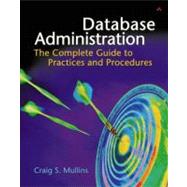A database management system (DBMS) is used to create databases. Most of today's applications deploy databases to store information such as names, addresses, and account balances. This information can be accessed and manipulated by application programs to perform business processes like payroll processing, sales processing, and customer billing. Every DBMS requires database administration to ensure efficient and effective use of databases by applications. This means that any user of Oracle, Microsoft SQL Server, DB2, Informix, Sybase, MySQL, Teradata, PostgreSQL, Ingres and any other popular DBMSs will benefit from the information in this book.
This book provides the industry's first non-product-based description of database administration techniques and practices. Many organizations have multiple DBMS products and will benefit from a consolidated view of database administration that does not focus on the internals and nuances of each particular product. Such a view is presented in this text.
The book defines the job of database administrator and outlines what is required of a database administrator, or DBA, in clear, easy-to-understand language. The book can be used
- As a text for learning the discipline of database administration
- As the basis for setting up a DBA group
- To augment a DBMS-specific manual or textbook
- To help explain to upper-level management what a DBA is, and why the position is required
Every organization that deploys databases using a DBMS needs to understand the concepts outlined in this book. Many small- to medium-sized organizations attempt to implement DBMS products without a DBA. This book explains the practice of database administration and underscores the necessity of a DBA for DBMS implementation to succeed. Other organizations implement only subsets of the database administration practices that are covered in this book. With a thorough reading of Database Administration: The Complete Guide to Practices and Procedures, it will become quite clear that a comprehensive approach to database administration is required. This book examines and explains each of the components that comprise this discipline.
As technology advances, new IT techniques emerge that impact the discipline of database administration. Two such areas are Internet-enabled database access and the storage of procedural logic in the DBMS in the form of triggers, user-defined functions, and stored procedures. Because the impact of these newer technologies and techniques on the role of the DBA is examined in this book, even seasoned database professionals will find the book useful. Indeed, the book will be helpful for any and all of the following folks:
- DBA managers
- IT professionals who want to become DBAs
- IT professionals new to implementing a DBMS
- Students of database management
- DBAs
- Systems programmers and system administrators who interface with DBAs and need to understand what it is that DBAs do
Because this book covers heterogeneous database administration without focusing on just one DBMS, it can be used by organizations to set up a DBA function when more than one DBMS product is being used. This is particularly important because the single-DBMS shop is a rarity these days. Analysts estimate that most medium- to large-sized organizations have from three to ten different DBMS products in use—all requiring administration.
Additionally, DBA is currently a very hot job. In many cases, DBAs demand and obtain very high salaries. As such, many technicians aspire to become DBAs, and this book will help them to do just that. If you are an IT professional with an interest in becoming a DBA, this book will help you to achieve that objective.
Other books about database administration are available, but they approach the subject from the perspective of a single DBMS. Many of these books are quite good. I wrote one myself about DB2. This book is not intended to replace such books, but to augment them with an independent treatment of database administration tasks.
How to Use This Book
This book can be used as both a tutorial and a reference. The book is organized to proceed chronologically through DBA tasks that are likely to be encountered. Therefore, if you read the book sequentially from Chapter 1 through Chapter 23, you will get a comprehensive sequential overview of the DBA job. Alternatively, you can read any chapter independently because each chapter deals with a single topic. References to other chapters are clearly made if other material in the book would aid the reader's understanding.
0201741296P05292002








